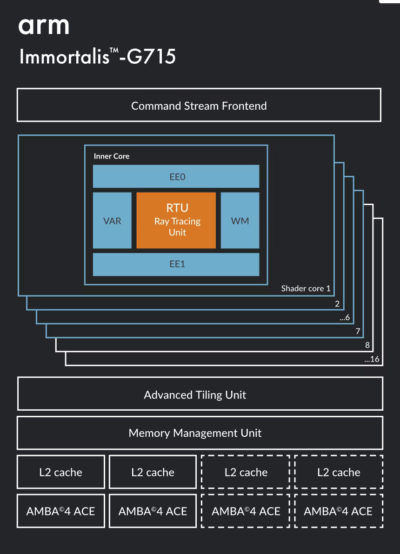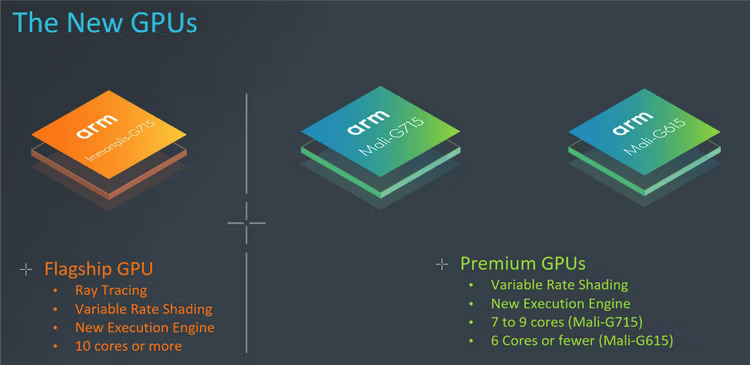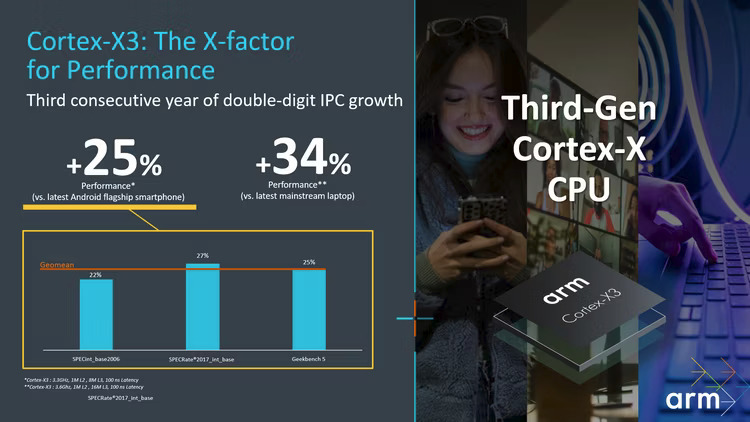ARM has announced today its new CPUs and GPUs, which, in the next two years, will be incorporated into the chips of future smartphones.
The most important announcement is that of the new ARM GPU which supports hardware ray tracing, a feature hitherto limited to the latest video game consoles and high-end PC graphics cards, though Samsung got ahead of ARM.
The new GPU, Immortalis-G715, it is based on the same Mali architecture used by many ARM GPUs. Mali’s designs sometimes lag behind in performance compared to other companies in the industry, but ARM claims there are big performance gains here.
Immortalis offers hardware-based ray tracing support (compatible with the Vulkan API), variable rate shading, matrix multiplication instruction support, and expanded developer tools and support.

ARM claims that improves performance by 15% compared to previous solutions and that doubles the performance of machine learning. The company claims it is also 15% more energy efficient which could equate to reduced power consumption or operating temperatures.
Ray tracing translates to better reflections and lighting in rendered scenes, and it’s worth noting that ARM isn’t the first to announce a mobile chipset with this feature. The Samsung Exynos 2200 introduced in January features an AMD-based GPU that also claims to offer hardware-accelerated ray tracing.
Many of the details presented by ARM were later qualified by explaining that the details and benefits will vary depending on the implementation chosen by the chipset manufacturers; that is, ARM has these layouts, but can scale them up or down depending on the manufacturer’s requirements.
Ultimately, they can use and tweak it within those limits as they see fit, adjusting things like number of cores or other metrics to suit their design. The G715 can be configured with 10 cores or more (no upper limit provided).
ARM has not directly mentioned any partner that will use the technology, but MediaTek he did congratulate the company on its announcement, which could be a clue. MediaTek has also previously used Mali GPUs in its products.
ARM has given fewer details about the smaller GPUs, but the Immortals has a couple of smaller siblings that it shares its architecture with. The G715 it replaces last year’s G710 and inherits some of the features of the G715-Immortalis, such as variable rate shading.
Presumably the two designs share many aspects, but the G715 will not have hardware-based ray tracing. It will be available in 7 to 9 core designs.
The G615Slightly lower-end, it replaces last year’s G610 and offers the same features, but comes in 6-core or less designs.

The new Cortex-X3 It is a high-performance ARMv9 CPU design. ARM reaffirms that the IPC has improved by double digits. This means that we have a new big and fast core that will debut on high-end chipsets.
Technical improvements include 50% greater L1/L2 buffer capacity and 10x greater L0 capacity.
Outside of smartphones, the X3 can be used in up to 12-core configurations for devices like laptops and desktops, and ARM says the new design offers a 34% improvement in single-thread performance compared to the latest PCs. conventional laptops.

The Cortex-A715 it offers improvements over the A710 in things like branch prediction accuracy and data preloading, as well as offering “steady IPC gains”. In fact, ARM claims that the A715 matches the performance of the Cortex-X1, the first of ARM’s “super-large” cores that landed in 2020 as part of its custom CPU program.
Compared to the old A710, it is 20% more energy efficient when running at the same level of performance and 5% faster at its peak.
This year there is no new small ARMv9 kernel. Instead, ARM has increased the efficiency of last year’s Cortex-A510, marginally improving its efficiency at the same level of performance, saving around 5% power, according to ARM.














